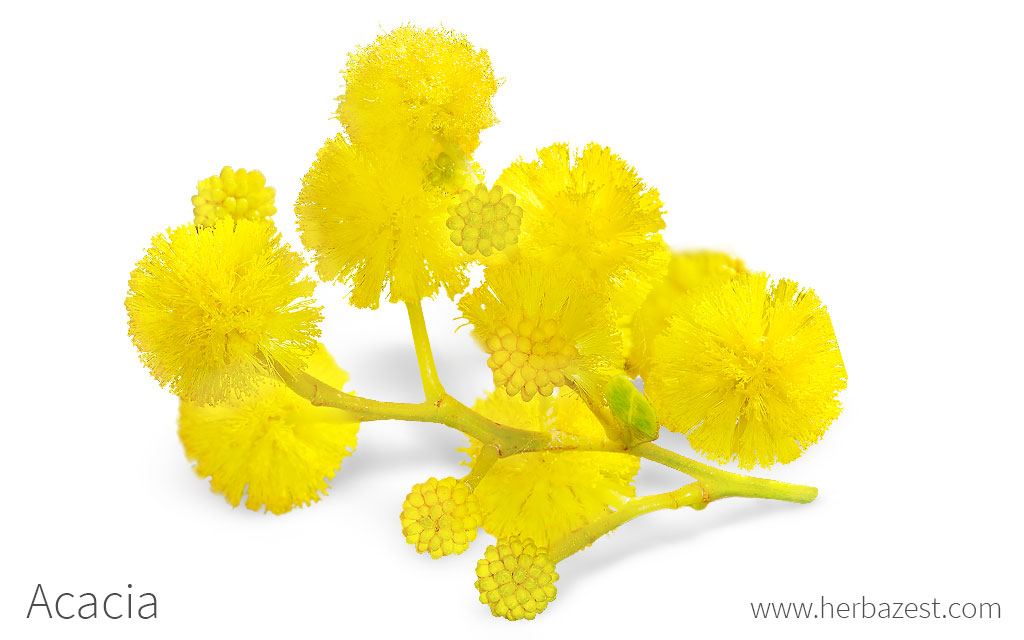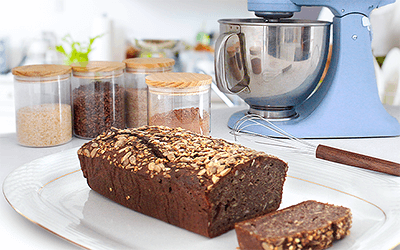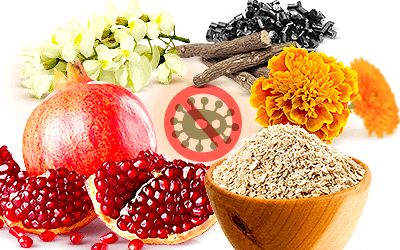Acacia - also known as wattle - has a history of human use that scientifically dates back to as early as 40 CE, with the mention of Acacia nilotica from Greek botanist Discorides. Later, it appeared in Pliny's herbal treatises as an established part of Roman herbal medicine. Today, acacia species have been planted in more than 80 countries worldwide. It is most commonly found in Australia, Africa, Southeast Asia, and the Americas.
Acacia Medicinal Properties
- Medicinal action Astringent, Hepatoprotective
- Key constituents Phenols, alkaloids, flavonoids, tannins, sterols, saponins, fiber
- Ways to use Capsules, Decoctions, Hot infusions/tisanes, Liquid extracts, Tincture, Powder, Ointment, Essential oil
- Medicinal rating (2) Minorly useful plant
- Safety ranking Safe
Health Benefits of Acacia
Acacia exhibits various pharmaceutical activities due to many of its chemical compounds, mainly phenols, alkaloids, flavonoids, and tannins. Acacia is also recognized for its high fiber content, further contributing to its astringent, antiviral, and antioxidant benefits, which lead to its use in the following manners:
Healing wounds. Research has shown that aqueous extracts of Acacia auriculiformis stem bark possess significant astringent properties.
Preventing liver damage. Acacia mellifera leaf extracts have been proven to be hepatoprotective.
Additionally, acacia's water-soluble fiber not only helps reduce the risk of developing diabetes by regulating blood sugar levels, but also promotes colon health by increasing weight and size of stool, making it pass through the digestive tract more easily.
How It Works
Research studies have found that the presence of phenols, tannins, and flavonoids within acacia help speed wound recovery and inhibit microbial growth.1 These phytoconstituents encourage tissue contraction, as well as the formation of of capillary vessels and fibroblasts, which are cells that produce collagen and help regenerate tissue.
Acacia extracts have proven useful in normalizing triglycerides and cholesterol levels2, as well as in regenerating damaged tissue.
Additionally, the presence of alkaloids, flavonoids, tannins, sterols, and saponins in acacia plants have been shown to have hepatoprotective action.3
Furthermore, acacia is a good source of water-soluble fiber, which keeps blood sugar levels under control by slowing down the digestion and absorption of carbohydrates. Acacia's natural compounds also increase insulin sensitivity, reducing the risk of diabetes by preventing resistance to this natural glucose-regulating hormone.
VARIOUS PHYTOCONSTITUENTS OF ACACIA HELP PROMOTE WOUND HEALING.
Astringent properties can be found in herbs like agrimony and goldenseal, whereas chicory, dandelion, and hepatica have hepatoprotective actions.
Acacia Side Effects
Acacia is likely safe when consumed in moderation by adults. However, due to its high fiber content, overconsumption can lead to gas, bloating, and diarrhea.
Acacia Cautions
There are no studies disproving the safety of acacia usage for women who are pregnant or breastfeeding. However, it is best to avoid medicinal use during these stages, unless it is under medical supervision.
Acacia can prevent the absorption of antibiotics used to treat bacterial infections, such as amoxicillin. In order to avoid this interaction, acacia should be taken at least four hours before consuming the medication.
How to Consume Acacia
- Edible parts Nectar, Sap
- Edible uses Flavoring, Beverage, Sweetener
- Taste Sweet
Acacia is commonly consumed as a source of water-soluble dietary fiber. The gum is often exuded through the hardened tree sap and crushed into powder. However, due to the herb's abundant medicinal properties, it is also consumed in a variety of traditional remedies and products.
Natural Forms
Decoction. Traditionally, fresh acacia leaves are boiled with inner bark juice for ameliorating diarrhea and stomachaches. Powdered leaves, stems, and pods can also be used in this manner, as they are thought to help cure diarrhea, malaria, and dysentery.
Infusion. Acacia roots can be steeped in hot water to make an infusion that helps soothe mucous membranes, reduce inflammation, and attack microbial infections.
Powder. Acacia powder can be taken to increase fiber ingestion. Subsequently, it regulates the digestive tract and helps control weight.
Herbal Remedies & Supplements
- Honey. Acacia honey is made from tree blossom nectar and is known for its therapeutic action of cleansing the liver and regulating the intestines. It can be used as a substitute for traditional honey in tea and on bread, among other methods.
Tincture. A concentrated solution is made by macerating the crushed parts of the plant in alcohol. This preparation needs to be diluted in water to safely reap acacia's anti-inflammatory and antiviral benefits.
Liquid extract. Acacia leaf liquid extract has traditionally been used as a remedy for tuberculosis. A mouthwash or gargle from the extract is also used to help treat sore throats, gum disease, and other forms of oral inflammation.
Salve. Acacia flower salves or ointments are traditionally used to support digestive disorders. Apply to the desired body area with a moist wool pad or fingers up to twice daily.
Essential oil. Acacia essential oil can be used in aromatherapy diffusers to relieve stress and nervous exhaustion. It is also a popular ingredient in massage, bath, and perfume oils for its delicately sweet, floral scent.
- Capsules. Made from the sap of the tree, acacia fiber supplements are used to support digestive health and regularity.
Growing
- Life cycle Perennial
- Harvested parts Flowers, Bark, Wood
- Light requirements Full sun, Partial shade
- Soil Well-drained
- Soil pH 6.1 – 6.5 (Slightly acidic), 6.6 – 7.3 (Neutral)
- Growing habitat Arid or desert regions, Semi-arid regions, Subtropical deserts
- Pre-germination seed treatment Scarification
- Potential insect pests Bugs, Mites
- Potential diseases Leaf spot, Rust, Fusarium wilt, Plant galls
- Potential animal pests Birds
While the optimum climatic zone depend on the species, acacia varieties are commonly found in arid, semi-arid, and dry subtropical areas. They vary in size, but are mostly classified as large shrubs or small trees. Most species are evergreen and bloom in January and February.
Growing Guidelines
As most species of acacia are native to tropics or temperate zones, they prefer full sun. However, they are hardy plants and can thrive in both extremely wet and very dry ecosystems.
Acacia trees require well-drained soil, as the roots are delicate and susceptible to excess water.
Acacias are able to form symbiotic associations with bacteria to fix atmospheric nitrogen, which makes them suitable for poor soils. However, in the desert landscapes where this plant naturally grows, a pH of 6.2 - 6.9 is the standard.
Acacias can tolerate dry spells; however, they ideally require deep irrigation every one to two weeks.
Acacia trees can be propagated by seeds, grafts, or cuttings. If seed propagation is chosen, the hard pericarps will need a period of scarification to promote germination.
Further information on growing acacia can be found in the herb garden section.
Additional Information
- Other uses Cosmetics, Furniture/carpentry, Perfume, Timber
Plant Biology
The Acacia genus is characterized by its unusually-shaped trees and shrubs, which typically display branches and stems growing upwards, as well as leaves and flowers that grow from the tips of those branches. Small leaflets provide the stalk a fern-like or pinnate appearance. Depending on the species, acacia trees can reach a height of 70 - 80 feet (21 - 24 m), with a diameter of three feet (1 m). Foliage colors vary from silver-gray to blue. Small blooms compose the flower, which has the appearance of a yellow ball. Tiny petals are situated behind long stamens, and the legumes contain acacia seeds.
Classification
Acacia is one of the largest genera of trees and shrubs in the world, and belongs to the Fabaceae or bean family, which comprises 700 genera and about 17,000 species, including economically important crops such as alfalfa (Medicago sativa), beans (Phaseolus vulgaris), fenugreek (Trigonella foenum-graecum), soy (Glycine max), and tamarind (Tamarindus Indica).
Acacia plants are considered woody legumes. They occur naturally on all continents except Europe and Antarctica, and range in size from small shrubs to large forest trees.
Varieties and Species of Acacia
Worldwide, there are approximately 1,300 varieties of acacias, most of them native to Australia. The five most common species of Acacia are acacia (from Australia and tropical Asia); acaciella and mariosousa (from the Americas); and vachellia and senegalia (from outside Australia).
In Australia, the plant is also referred to as a wattle. The golden wattle, or Acacia pycnantha, is the country's national flower. In the United States, as well as in Africa, it is simply called acacia tree.
Historical Information
The acacia plant is believed to have been in use by humans since Egyptian civilization, when it was considered sacred, and vessels were made from the plant's wood. However, the widely-accepted origin of the acacia tree in common use dates back to 40 - 90 CE, when the Greek botanist Discorides mentioned Acacia nilotica in his treatise Materia Medica. Later, the medicinal use of the wood and flowers was mentioned by first-century Roman Pliny the Elder in his Natural History book.
By the 17th century, acacia seed was introduced to North America by the herbalist Jean Robin, and its popularity continued from there. To this day, the plant as retained its utility for industrial and medicinal uses.
Economic Data
There are more than two million hectares of commercial acacia plantations distributed throughout Asia and Africa, as well as in Central and South America. Acacia's suitability to desert landscapes and its robust growth, paired with its copious seed production, has resulted in the rapid flourishing of industrial plantations.
Arabic gum is generally harvested from Acacia senegal, since this species is praised for having superior properties. Consequently, acacia gum has dominated the international trade market. The major importers of A. senegal gum are the European Union, United States, and India. Chad, Sudan, and Nigeria are the largest producers of this gum.
Popular Beliefs
Some believe that Acacia seyal, the shittah tree of the Bible, was used in the construction of the Ark of the Covenant and that acacia is a symbol of the eternal soul.
Other Uses
Gardening. The acacia plant is used in a variety of products. The tree is planted for ornamental purposes in parks and gardens, and its woolly flowers are used in perfumes for their sweet fragrance.
Carpentry. Household furniture is also made from acacia timber. Timber from Acacia melanoxylon, also known as Australian blackwood, is of specific prized quality for its durability and high polish.
Gum. Acacia gum, also known as arabic gum, is soluble in water and foods and is often used as an emulsifier, stabilizer, and thickener.
Confectionery industry. Acacia's gum is used as an ingredient for candies, jellies, glazes, and chewing gum.
Beverage industry. It has also been used as a stabilizer in soft drinks and beers.
Cosmetic industry. Arabic gum is also used as an adhesive for face masks and powders, and to give lotions a smooth feel.
Acacia has been used throughout thousands of years in the preparation of food, medicines, cosmetics, and more. Its medicinal uses span from helping heal wounds and preventing liver damage to controlling blood sugar levels and maintaining healthy bowel movements. Whether purchased as a gum or in another form, this herb's benefits make it worth a try.
Sources
- Encyclopedia of Cultivated Plants: From Acacia to Zinnia, pp. 1-3
- FAOIPGRI Technical Guidelines for the Safe Movement of Germaplasm, No. 20, Acacia spp.
- Journal of Ranch Management, Biological and physical factors influencing Acacia constricta and Prosopis velutina establishment in the Sonoran Desert, 1993
- The American Journal of Clinical Nutrition, Cholesterol-lowering effects of dietary fiber: a meta-analysis, 1999
- The Good Carbohydrate Revolution, pp. 57-59
- University of California, Agriculture & Natural Resources: Acacia
- Kew Royal Botanic Gardens, Acacia senegal (gum arabic)
Foodnotes:
- Asian Journal of Pharmaceutical and Clinical Research. (2014). Evaluation of Wound Healing Activity of Acacia Auriculiformis A. Cunn. Stem Bark. Retrieved June 25, 2021 from https://www.researchgate.net/publication/287309492_Evaluation_of_wound_healing_activity_of_Acacia_auriculiformis_A_Cunn_stem_bark
- Frontiers in Physiology. (2015). The lowering effect of Gum Arabic on hyperlipidemia in Sudanese patients. Retrieved June 25, 2021 from https://www.ncbi.nlm.nih.gov/pmc/articles/PMC4434902/
- BioMed Research International. (2015). Hepatoprotective and Antiviral Efficacy of Acacia mellifera Leaves Fractions against Hepatitis B Virus. Retrieved June 25, 2021 from https://www.hindawi.com/journals/bmri/2015/929131/







